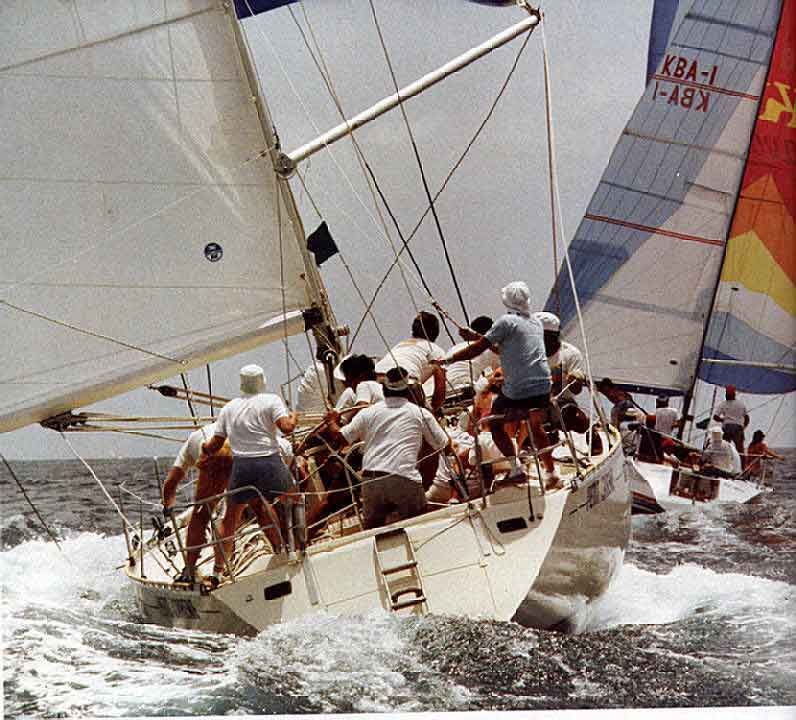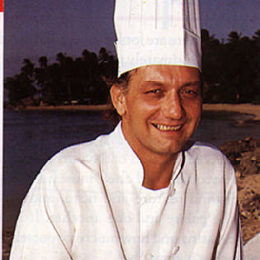Sailors will say that the best thing about it is the ideal conditions. The landlubbers will vouch for the “happy hour” after each race, while the daytrippers will opt for the fun and games of Lay Day.
Within a few years, the Angostura Tobago Sailing Week has drawn superlatives from all manner of participants and has established a reputation for thrills and excitement in beautiful surroundings.
It is still a mere stripling compared with the older and more illustrious Antigua Sailing Week, which celebrates its 25th anniversary in 1992. And due to her southerly location, Tobago may never attract the fleet and crowds of her northern cousin. But those who have been there will attest to the island’s charms and those of the annual sailing week in May, when members of the Trinidad and Tobago Yachting Association and their friends and families, along with a few of their neighbours from other islands, take over the Crown Point Hotel.
The Tobago event first saw the light of day in the early eighties, when it was based at Turtle Beach on the island’s leeward side. It had a brief fling in the sun before the TTYA people decided, due to financial constraints on the part of members, to host their annual week in the fickle Gulf of Paria winds, which can be a frustrating sail at the best of times, especially when overseas participants from Martinique and Barbados have made the trek to reciprocate the visit of Trinidad yachts to their regattas.
But TTYA officials rethought their position, probably after one too many spells in the Gulfs doldrums; they made a concerted effort to establish Tobago as the ideal destination for yachtsmen and put their energies into making the Angostura-sponsored Sailing Week an important date on the international yachting calendar.
So the event began anew in 1988 with just the TTYA boats. Despite one of the races being an energy-sapping, bone-wearying round-the-island slog which took the smaller craft almost 12 hours and is no longer part of the week, everyone had a whale of a time in the home-away-from-home atmosphere. Rawle Barrow’s Petit Careme was tops in the Racing Class.
The fleet grew the following year, with the arrival of the Bajans, who brought their zest for life and their love of Trinidad calypso to Tobago.
At first they voiced their share of criticisms of Trinidad rum and praised their Bajan brews to the high heavens (a long-standing argument), in between choruses of the Mighty Sparrow’s Congo Man. But when they left, wind-washed, sun-burnt, hungover and carrying the sign they had posted outside their Crown Point assembly room (“Barbados Game Reserve), most of them had nothing but praise for the sponsor’s flagship product, Royal Oak Deluxe Rum, and for the conditions offshore.
After all, they had swept the honours out there, in both Racing and Cruising Classes (not to mention the Lay Day games), on the deep blue waters driven by strong and consistent winds, which added up to top-class sailing for all involved.
One visiting yacht even made the trek down south from Antigua in 1990, when the locals improved their act to give the Bajans a run for their money.
But the Bajan skipper Jackie Head, an international dinghy champion in his youth, joint-owner Charles “Reds” Packer and the crew of Blazin’ were again the toast of the prize-giving night and stole the show for the second consecutive year.
They weren’t able to make it back for the hat-trick in the Racing Class last year, but the blue and yellow flag of Barbados was still flying high at the end of another great week of keen and exciting competition. For after playing second fiddle in previous years to their counterparts in Blazin’, Ralph Johnson and the boys and girl aboard Bruggadung II took the title. It was fitting reward for Johnson and his crew, who have become an established and ever-lively presence during the Sailing Week. They first came to Tobago with Bruggadung I, and it gave the skipper great pleasure to pull off the Racing Class victory in his new boat, since he had encountered many problems in setting her up after breaking his mast in a regatta in Barbados at the end of 1990.
And when it was all over, the Bruggadung people were not the only ones who could talk about broken masts. For Glenn Castagne, his son Justin and their able crewman Bobby Sheppard, aboard the tiny yacht Andante, experienced what must be the most frightening few seconds in yachting: the two mainstays popped like gunshots in close to 30 knots of breeze on the choppy beat up to the Bulldog marker off Lowlands on the windward side of Tobago, and then the mast buckled and fell into the sea.
Luckily, all escaped injury, and Sheppard, once known as The Mouth and now referred to as Mighty Breakmast, had many stories to tell. He will also recall the adventures of the Screaming Eagles, members of Legacy, the top local yacht, whose veteran skipper Douglas Myers is on record as saying “They are the best in the West Indies, perhaps even the world, from five minutes to the gun until we cross the line at the end of the race, but outside of that, they are a complete waste of time.
After executing some breathtaking and faultless manoeuvres, the Legacy crew made a splash at the prizegiving dinner when they climbed up on high and belly-flopped into the stack of balloons decorating the swimming pool.
Also making their presence felt at the Sailing Week over the years have been the Tobagonian sailors. They thrill onlookers with their exploits in the land’s traditional sailing vessels, known as Bum Boats, which have become an integral part of the proceedings, and get the week off to a wild and crazy start with three races on the Sunday.
The Bum Boat sailors, the Screaming Eagles, Mighty Breakmast, hopefully the crews of Bruggadung II and Blazin’ and other visitors, will all be in Tobago again this year (1992), from May 10 to 15, for the fifth Angostura Tobago Sailing Week. You would do well to be there too!






















